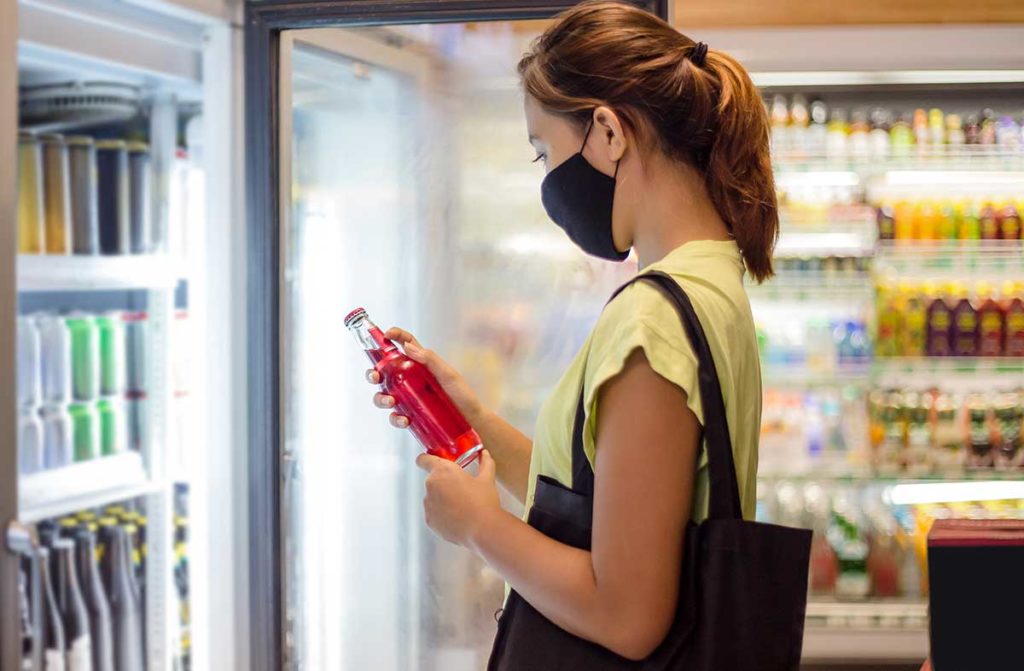Partners for Growth caught up with Unilever Category Director, Kat Simpson, to understand what impact the pandemic and subsequent lockdown restrictions has had on shopper buying behaviour within the convenience channel.
What overall impact has the pandemic had on shopper behaviour?
With more people staying at home and working from home, we saw a big shift to people shopping locally and online, which have been the two channels to see the most growth.
Whilst convenience has dropped back from its peak in 2020, we are still expecting it to continue to grow until 2023, as people have reengaged with the value and benefits of a community convenience store. It’s online shopping that has been the biggest winner taking share from supermarkets, as shoppers have turned to it doing their best to avoid the virus and having experienced the benefits of online first hand, they have overcome their resistance to it. Shopping online is now becoming a new routine and habit and a more mainstream retailer channel. With increasing retail and supplier resource being directed to online, we can only see this channel continuing to grow strongly.
What specific areas of change have you seen in convenience?
Overall growth in convenience has been driven by shoppers choosing to visit fewer stores to protect themselves from the virus and choosing to get more of their main shop during these local store visits. As a result, the convenience basket spend increased dramatically during the first lockdown. For many convenience retailers, basket spend and sales were driven up when they implemented on-demand delivery services to help their community stay safe and retailer feedback suggests that these delivery orders substantially drove up basket spend, as well as growing customer loyalty. Although sales have dropped back from the peak levels of the first lockdown, as government restrictions continue to be enforced, they are still significantly higher than pre Covid levels.
However, not all areas of the store have shown growth, food-to-go sales in particular have dropped back because of the reduced footfall from people staying at home. Additionally, sales of impulse categories such as soft drinks and confectionery have fallen significantly, as fewer shoppers are visiting the stores.
We have also noticed that with more time on their hands, shoppers have taken the opportunity to reflect, making changes to their routines to embrace well-being whilst staying at home.
What have been the main trends driving changes in your core categories?
We have seen significant changes in shopper behaviour across many of our categories. The categories where the virus has had the most direct growth spike impact include personal care, home hygiene and laundry, clearly driven by shoppers wanting to protect themselves and their loved ones from infection risks.
So, what changes have there been in personal care?
Health & beauty products have been growing exponentially over the last 10 years, however, they have accelerated dramatically during the pandemic, with sales of personal care products through local convenience stores growing by 42% and now worth £312m to the convenience channel*.
If we analyse this further, we see how the dramatic changes in consumer consideration of where and how often they buy personal care products have driven this growth. The increasing importance of convenience retailers to shoppers coupled with the increasing need to wash our hands more frequently, has seen hand wash products grow by a staggering 320% in convenience.
The Personal Care category priorities have not only changed in massive favour of hand-washing, we have also seen considerable growth in the other personal hygiene subcategories including Haircare (+50%), Skincare (+42%) and Shower (31%)*.
These dramatic changes mean retailers need to review their range to ensure they are meeting the new shopper need states within convenience personal care settings – more information can be found on the Partners for Growth website.
What has been driving growth in home cleaning and laundry products?
The importance of hygiene is being more frequently and extensively communicated in the media and furthermore, more people are spending more of their time at home. These factors have meant over a two-third increase in household cleaning frequency during 2020.
This increase in shoppers buying into the subcategory more frequently has had a direct knock-on effect to sales, as you would expect, and we have seen household cleaning sales value grow 60% year on year*. In fact, it would be fair to say that cleaning is fast becoming an essential national habit and convenience retailers will need to flex their range to provide shoppers with their product and category needs.
Laundry has always been a crucial part of a customers’ everyday shop with 92% of shoppers buying into this category. Nevertheless, we have seen a 42% increase in usage as a result of the pandemic* and it is important to consider your ranging and merchandising in this high penetration, growth category. More advice can be found on our Laundry page here.
What other factors have been driving changes in shopper behaviour?
We have seen some interesting drivers of behavioural change during the pandemic and unsurprisingly health and wellness has been a big driver for many of them.
Take the Tea category for example, which has seen occasions grow to a five year high during the pandemic, as more households are consuming more tea at home*.
In part this has been driven by snacking and lunching occasions, both of which are up 14%*, but there is also an increasing trend to treating tea as an ‘occasion’ and as a result both value and volume are up in this category.
A big driver has been the national media communication around the importance of being healthy during the pandemic. This has resulted in an increasing trend for people to consume more speciality teas as part of their daily ‘wellness’ ritual to try to stay physically and mentally fit, either as a moment of pleasure, a transition into the working day, or relaxing after work back into home life.
What has been the impact on ice cream sales?
Whilst ice cream categories Impulse and Out of Home sales have suffered due to lockdown restrictions causing lower foot fall in shops as well as hospitality venues being closed, Take-Home ice cream category has seen a 30% increase in sales this year**. This has largely been driven by shoppers swapping meals in restaurants for dinners at home, often including a dessert or ice cream.
Interestingly, as noted in the last recession, we are seeing sales of premium ice cream growing faster than the rest of ice cream, as more furloughed and budgeting shoppers opt for the odd permissible treat.
What impact are recessionary fears having on sales?
The pandemic has had a big impact on shopper confidence, with many households being forced to tighten their belts as they face job losses or significantly reduced household income because of being furloughed.
With recessionary pressures continuing to increase at a time when more people have been staying at home, many households have turned to scratch cooking to make their household budgets go further. We have seen 40% increase in scratch cooking ‘occasions’ as these enable households to make a saving of 13p, or 10% per serving on average*. What’s more, we anticipate that plant-based products will continue to grow ahead of meat-based products, as the average cost of a meat-free meal is £0.88 versus £1.81 where meat or fish is included*.
Consumers are also seeking diets that reduce their carbon footprint while improving their health and this has motivated one in three people living in the UK to follow a mainly vegetable based diet with occasional meat dishes and to consider themselves as ‘Flexitarians’***. Convenience retailers need to be both price and product sensitive to optimise on these cooking ingredient sales, encapsulating the messages on how shoppers not only can save money, but also be more sustainable and improve their health.
What is your advice to help retailers cater for these changes in shopper behaviour?
The significance of the changes in shopper behaviour because of the pandemic cannot be understated. Until people feel more confident about returning back to their normal lives, I would encourage retailers to look carefully at the updated and unbiased category advice on the Partners for Growth website and ensure that their ranging and merchandising decisions consider this impartial advice. By doing this, they can be confident that they are catering for the dramatic changes in shopper behaviour resulting from the pandemic.
* Kantar L24W 9th September 20. ** Nielsen MAT 3rd October 2020 (Total Impulse)





84 Responses
5nl30i
2o2w3d
fyfuw8
oq3v2g
j0qoxz
trrcuq
rff0z0
gd5klk
4jzumn
jde9ds
cy4az6
zs36cp
tp929x
16bqzc
uxby5c
h12pek
u3eyc5
g165v2
hd0lvh
quiior
gxxio3
7enu8h
1ibxag
9o0euu
t3nre2
0zjzch
9id3zg
kcoeo0
radsug
7qwugz
ux9fdt
0lu4cs
9lg7ld
ucohun
I was studying some of your blog posts on this internet site and I think this website is very instructive! Continue posting.
Neat blog! Is your theme custom made or did you download it from somewhere? A theme like yours with a few simple adjustements would really make my blog shine. Please let me know where you got your design. With thanks
Very interesting topic, thank you for putting up.
I have been reading out many of your articles and i can state nice stuff. I will make sure to bookmark your blog.
Thank you for the good writeup. It in fact was a amusement account it. Look advanced to more added agreeable from you! However, how can we communicate?
Hello very nice web site!! Guy .. Excellent .. Superb .. I’ll bookmark your site and take the feeds additionally?KI am glad to seek out a lot of helpful information right here within the submit, we want develop extra strategies in this regard, thanks for sharing. . . . . .
After research a number of of the weblog posts in your website now, and I actually like your approach of blogging. I bookmarked it to my bookmark website record and will likely be checking again soon. Pls try my web page as effectively and let me know what you think.
I love the efforts you have put in this, thank you for all the great posts.
You are my breathing in, I possess few web logs and very sporadically run out from post :). “Truth springs from argument amongst friends.” by David Hume.
It’s the best time to make a few plans for the future and it’s time to be happy. I’ve read this submit and if I may I wish to suggest you some interesting issues or suggestions. Perhaps you can write next articles regarding this article. I want to learn even more things approximately it!
naturally like your website but you have to check the spelling on several of your posts. Many of them are rife with spelling problems and I find it very bothersome to tell the truth nevertheless I will certainly come back again.
wh9ixb
This really answered my problem, thank you!
max418
I like this web site very much so much great info .
gcdkkg
Hey there, You’ve done an incredible job. I will certainly digg it and personally recommend to my friends. I’m sure they’ll be benefited from this web site.
I am not real wonderful with English but I come up this very leisurely to read .
2xk3p7
i5218y
I have learn a few excellent stuff here. Certainly value bookmarking for revisiting. I wonder how so much effort you set to create this type of great informative web site.
Really clean site, regards for this post.
diqfgr
Very interesting subject, appreciate it for posting.
Thanks , I have recently been looking for information about this topic for ages and yours is the best I have discovered till now. But, what about the conclusion? Are you sure about the source?
a7a963
I’ve been absent for a while, but now I remember why I used to love this web site. Thanks , I¦ll try and check back more frequently. How frequently you update your web site?
You are my inspiration, I own few web logs and occasionally run out from brand :). “‘Tis the most tender part of love, each other to forgive.” by John Sheffield.
You are my inhalation, I possess few web logs and often run out from to post .
I adore looking through and I conceive this website got some really utilitarian stuff on it! .
I see something truly special in this internet site.
I appreciate your piece of work, thankyou for all the great blog posts.
UK Personal Protection Ltd offers SIA-licensed bodyguards for hire in London, across the UK, or worldwide. Their operatives are highly trained in close protection, anti-ambush, hijack response and first aid, delivering confidential, bespoke security solutions to VIPs, executives, diplomats, and high-risk individuals.
Hey! This is kind of off topic but I need some guidance from an established blog. Is it very hard to set up your own blog? I’m not very techincal but I can figure things out pretty quick. I’m thinking about setting up my own but I’m not sure where to begin. Do you have any ideas or suggestions? Many thanks
It’s really a cool and useful piece of info. I’m glad that you shared this helpful information with us. Please keep us up to date like this. Thanks for sharing.
What does a Farmasi Europa Beauty Influencer account mean? Earn money at your own pace and personally with Farmasi Europa. Five major European countries have joined Farmasi Europa: Spain, Great Britain, France, Italy, Portugal. A bunch of countries that have accumulated tens of thousands of Farmasi Europa beauty influencers.
What does a Farmasi Europa Beauty Influencer account mean? Earn money at your own pace and personally with Farmasi Europa. Five major European countries have joined Farmasi Europa: Spain, Great Britain, France, Italy, Portugal. A bunch of countries that have accumulated tens of thousands of Farmasi Europa beauty influencers.
Enjoyed reading this, very good stuff, thanks. “Curiosity killed the cat, but for a while I was a suspect.” by Steven Wright.
It’s a shame you don’t have a donate button! I’d without a doubt donate to this brilliant blog! I guess for now i’ll settle for bookmarking and adding your RSS feed to my Google account. I look forward to brand new updates and will talk about this site with my Facebook group. Talk soon!
Nutriplus Farmasi.com.ro suplimente alimentare și de sănătate unice pe piața din Europa. Ofertă unică pe piața suplimentelor din Europa: Nutriplus cu susținerea sănătății și a frumuseții din interior. Alege farmasi.com.ro pentru produsele Nutriplus România!
Attractive section of content. I just stumbled upon your site and in accession capital to assert that I get in fact enjoyed account your blog posts. Anyway I will be subscribing to your feeds and even I achievement you access consistently fast.
Very interesting points you have noted, thankyou for putting up. “You can tell the ideas of a nation by it’s advertisements.” by Douglas South Wind.
Hi, just required you to know I he added your site to my Google bookmarks due to your layout. But seriously, I believe your internet site has 1 in the freshest theme I??ve came across. It extremely helps make reading your blog significantly easier.
I’ve learn a few excellent stuff here. Definitely value bookmarking for revisiting. I surprise how a lot effort you set to make this kind of magnificent informative site.
I think this site has some very good info for everyone. “There is nothing so disagreeable, that a patient mind cannot find some solace for it.” by Lucius Annaeus Seneca.
It?¦s actually a cool and useful piece of information. I?¦m happy that you shared this useful info with us. Please keep us informed like this. Thanks for sharing.
It is the best time to make some plans for the longer term and it is time to be happy. I’ve learn this post and if I may I wish to counsel you few interesting things or tips. Perhaps you can write next articles relating to this article. I desire to learn even more things approximately it!
Hello there, just became aware of your blog through Google, and found that it’s really informative. I’m gonna watch out for brussels. I’ll be grateful if you continue this in future. Numerous people will be benefited from your writing. Cheers!
Thank you, I’ve recently been looking for information about this topic for a long time and yours is the greatest I’ve found out till now. However, what in regards to the bottom line? Are you sure about the source?
This is a very good tips especially to those new to blogosphere, brief and accurate information… Thanks for sharing this one. A must read article.